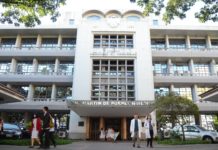THE PHILIPPINES probably has one of the worst breast cancer incidence rates in Asia, if the World Health Organization, the Department of Health, and the Philippine Cancer Society will be believed. And with its annual age-standardized rate of 47.7 breast cancer cases per 100,000 people (according to the Manila Cancer Registry and the 2002 International Journal of Cancer), the country is probably still number one in Southeast Asia.
The ironic thing is, this dreaded disease is not usually difficult to detect, and mere awareness about its nature could have saved so many Filipino women.
Breast cancer is a result of uncontrolled cell growth in the body brought about by mutations in the BRCA1 gene on chromosome 17q21 and the BRCA2 gene located on chromosome 13q12-13. They are otherwise known as breast cancer genes. This alarming disease remains to be the top cause of concern among women in all parts of the world.
The most common symptom among women, according to Dr. Menen Alsol, associate professor at the UST Faculty of Medicine and Surgery, Department of Pathology, is the presence of a mass or a kind of lump felt when examining the breast.
However, the manifestation that often causes alarm to many women is the continuous and chronic discharge (bloody or milky fluid) from the breast. This sign alone can be misleading, since the color of the discharge does not distinguish a mild condition (benign) from a severe (malignant) one. Serious illnesses have been associated with clear and bloody nipple discharges alike.
Most breast cancer symptoms are evident among women in the reproductive age group. Alsol told the Varsitarian that benign conditions of the breast can occur in individuals as young as 18 years old and recur intermittently until they reach ages 40 to 50. But some cases were also seen in the 50 to 60 age group.
Risks
Breast cancer development can be linked to an interplay of various factors that include genetic predisposition, environmental carcinogens, and radiation exposure. The most significant risk factor is having a genetic predisposition especially if one has a first-degree relative suffering from a breast disease, most notably, breast cancer.
According to the 1992 New England Journal of Medicine, the age of menarche (first menstruation) can be a gauge to determine relative risk of developing breast cancer. The early onset of menstrual cycles and late menopause are considerable risks because of the prolonged exposure to estrogen.
Obesity is also one factor, although this remains controversial. Alcohol consumption has also been associated with breast cancer risk, according to the 1999 American Journal of Epidemiology.
Data from the National Cancer Institute suggest that frequency of breast cancer increases directly with the patient’s age. This is proven by the fact that 85% of the disease occurs after age 40.
Self-help
Although the genetic susceptibility to breast cancer cannot be reduced, the environmental risk factors can be prevented through lifestyle modifications such as exercise and weight control, avoidance of smoking, and decrease in alcohol consumption.
Patients with established breast tumors have no other choice but surgery and chemotherapy. According to the 1998 New England Journal of Medicine, chemotherapy decreases the odds of dying from breast cancer during the first 10 years following the diagnosis.
The treatments are generally expensive and long-term since this disease is an interplay of different factors. Prevention and a reduction in the risk factors can make a dent on the mortality rate.
In any case, early detection of the disease through breast self-examination remains the most practical remedy. In fact, a task force formed by the Cancer Genetics Studies Consortium in 1997 recommended this practice beginning age 20.
Breast examination must be done a few days immediately after the monthly menstrual period because it is the best time to detect changes in normal lumps or texture of the breasts. Soft thickenings on both breasts and small lumps are normal physical findings.
Palpation (feeling with the hands) should begin in the shower, since many women have increased tactile sensitivity when using a “wet” technique. After the shower, the woman should lie down, initially with one arm at her side and subsequently with the same arm underneath her head. The second, third, and fourth finger pads are used to palpate the opposite breast in a massaging motion with firm pressure. Ideally, a clockwise fashion is used beginning at the nipple and gradually circumscribing larger circles. This is repeated on the other breast.
The woman must do breast self-examination every month, taking note of the usual texture of her breast. She can also do this in front of the mirror to assess the symmetry of her two breasts or to check for any nipple discharge before beginning palpation.
Going “high-tech”
When practical breast self-examination yields dubious results, there are diagnostic equipment available in hospitals that will confirm or nullify suspicions. The University of Santo tomas Hospital (USTH) has an active Breast Clinic where diagnostic tests, treatments, and patient education are done. Some of the available tests at USTH are mammography and breast scanning. Under the Department of Pathology, cytology studies, fine needle aspiration biopsy (FNAB), and frozen sections on operated patients are done.
Mammography is an imaging examination of the breast by means of x-rays, ultrasound, and nuclear magnetic resonance. It is a comprehensive examination because it usually involves multiple individualized and specialized equipment and views. The extra views and magnifications increase the sensitivity and specificity of the procedure. It is also the most accurate conventional method of detecting nonpalpable (cannot be detected by breast self-examination) breast tumors.
On the other hand, FNAB is a simple office-based procedure that is well accepted because it is less painful. The breast mass is secured with one hand and the other hand introduces a 20- or 22-gauge needle attached to a 10- or 20-ml syringe into the mass.
With the application of these tests to a small mass, breast tumors are now highly curable at an early stage. This in turn results in reduced mortality and lower incidence of other similar tumors of the breast.
This dreaded disease is not only detrimental to a person’s health but also to the person’s emotional and psychological well-being. As cited in the 2nd Philippine Conference on Breast Cancer last year, there is a need to address the lack of information and awareness on this malignancy especially in remote areas. It is a sad fate that some women with breast cancer simply waited for death to come to them while some did not even know that they had it. Cherie G. Clemente
















